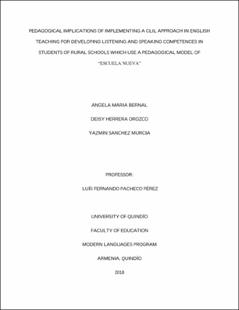Mostrar el registro sencillo del ítem
Pedagogical implications of implementing a clil approach in english teaching for developing listening and speaking competences in students of rural schools which use a pedagogical model of “escuela nueva”
| dc.contributor.advisor | Universidad del Quindío - Colombia - Asesor - Luís Fernando Pacheco Pérez | spa |
| dc.contributor.author | Bernal Salcedo Ángela María | spa |
| dc.contributor.author | Herrera Orozco Daisy | spa |
| dc.contributor.author | Sánchez Murcia Yazmin | spa |
| dc.date.accessioned | 2018-09-12T20:51:50Z | spa |
| dc.date.available | 2018-09-12T20:51:50Z | spa |
| dc.date.issued | 2018-05-27 | spa |
| dc.identifier.uri | http://bdigital.uniquindio.edu.co/handle/001/4452 | spa |
| dc.description | Pedagogical implications of implementing a clil approach in english teaching for developing listening and speaking competences in students of rural schools which use a pedagogical model of “escuela nueva” | spa |
| dc.description.abstract | The English level in rural schools is low, due to the difficulty that implies to teach the language for some teachers, even when they do not know other methods different to the traditional. The purpose of this research is showing how to teach through the CLIL methodology in a multigrade classroom and the repercussions it carries. Finally, it comes out the pedagogical implications after using English to improve listening and speaking competences under the approach exposed. | eng |
| dc.description.abstract | El nivel de inglés en las escuelas rurales es bajo, debido al grado de dificultad que implica enseñar el idioma para algunos profesores, y mucho más cuando no conocen otros métodos de enseñanza diferente a los tradicionales. El propósito de esta investigación es mostrar cómo enseñar a través de la metodología CLIL en un salón multigrado y algunas de las repercusiones que conlleva. Finalmente, se discuten las implicaciones pedagógicas de la enseñanza del inglés para mejorar las competencias auditivas y orales bajo después de aplicar la metodología propuesta. | spa |
| dc.description.tableofcontents | 1. Justification 9 2. Statement of the Problem 10 3. Problematic Question 12 | spa |
| dc.format.mimetype | application/pdf | spa |
| dc.language.iso | eng | spa |
| dc.publisher | Universidad del Quindío | spa |
| dc.rights | Derechos Reservados - Universidad del Quindío | spa |
| dc.rights.uri | https://creativecommons.org/licenses/by/4.0/ | spa |
| dc.title | Pedagogical implications of implementing a clil approach in english teaching for developing listening and speaking competences in students of rural schools which use a pedagogical model of “escuela nueva” | spa |
| dc.type | Trabajo de grado - Pregrado | spa |
| dc.rights.accessrights | info:eu-repo/semantics/closedAccess | spa |
| dc.rights.creativecommons | Atribución 4.0 Internacional (CC BY 4.0) | spa |
| dc.subject.proposal | Inglés, enseñanza, CLIL, implicaciones pedagógicas, habilidades auditivas y orales, Escuela Nueva. | spa |
| dc.type.coar | http://purl.org/coar/resource_type/c_7a1f | spa |
| dc.type.driver | info:eu-repo/semantics/bachelorThesis | spa |
| dc.type.version | info:eu-repo/semantics/draft | spa |
| dc.relation.references | Buck, G. (2000). Assessing listening. Cambridge: Cambridge University Press. Butzkamm (1998)Guía CLIL, Lifelong learning programme. Colbert &Arboleda, (1990);Universalization of Primary Education in Colombia, The New School Programme. Dewey, J. (1951). Buenos Aires: Losada, S.A. Dewey J. (2002), Democracia y Educación,2002, p. 97 Dewey, J. (1951). Buenos Aires: Losada, S.A. Futonge, Kisito (2005). Using English Videos and Music in EFL, ESL Classrooms. ESL Magazine: Read & Publish ESL articles. Fellows and liu (2008). Research Methods for Construction 3rd Edition. Editorial Wiley Blackwell. González-Gutiérrez, A., Regalado- Cañón, M. J., & Jiménez Espinosa, A. (2015). La pedagogía activa con metodología escuela nueva en Boyacá: el caso de dos municipios. quaest.disput, Vol. 8 (16), 83-10. Howard & Major. (2004); Guidelines for Designing Effective English Language Teaching Materials. Johnson, D. W., & Johnson, R. (2003). Student motivation in cooperative groups: Social interdependence theory. In R. Gillies & A. Ashman (Eds.). Cooperative learning: The 59 social and intellectual outcomes of learning in groups (pp. 136-176). New York: RoutledgeFalmer. Lochmiller, C; Lester, J. (2017) An Introduction to Educational Research.by Sage Publications INC. Matthews & Ross (2010); Research Methods: A Practical Guide for the Social Sciences. Editorial Pearson. Oxford, R. L. (1993). Research Update on Teaching L2 Listening. System, 21 (2). Rico Troncoso, C. (2013). Rasgos caracteristicos de la enseñanza de inglés como lengua extranjera en Colombia. Palabra maestra. Volumen 37. Pag 3-5 Rivers, W.M., & Temperley, M.S. (1978). A practical guide to the teaching of English as a second or foreign language. New York: Oxford University Press. Schiefelbein, E. (1991). In search of the school of the XXI century: Is the Colombian Escuela Nueva the right pathfinder? New York: UNICEF. Saricoban, A. (December 1999). The Teaching of Listening. The Internet TESLJournal. Sun, F. (2010). Pedagogical Implications to Teaching English Writing. Journal of Language Teaching and Research. Tejedor, M. La metodología CLIL y el desarrollo de estrategias de aprendizaje en educación primaria. Universdidad de Valladolid. Vero, E. & Puka, E. (2017). The importance of motivation in an educational environment. (pp. 62) | spa |
| dc.description.degreelevel | Pregrado | spa |
| dc.description.degreename | Licenciado en Lenguas Modernas | spa |
| dc.publisher.faculty | Educación - Licenciatura en Lenguas Modernas | spa |
| dc.type.content | Text | spa |
| dc.type.redcol | https://purl.org/redcol/resource_type/TP | spa |
| dc.type.coarversion | http://purl.org/coar/version/c_b1a7d7d4d402bcce | spa |
| dc.rights.coar | http://purl.org/coar/access_right/c_14cb | spa |














